Blepharoplasty, commonly known as eyelid surgery, is a cosmetic procedure aimed at rejuvenating the appearance of the eyes by removing excess skin, muscle, and fat from the eyelids. While this procedure has gained popularity for its ability to enhance facial aesthetics and address functional issues, concerns have been raised regarding its potential to cause blindness. In this article, we will delve into the question: Can blepharoplasty cause blindness? We will explore the scientific facts, evaluate the risks, and provide a comprehensive understanding of the procedure’s safety profile.
The Anatomy of the Eye
Before delving into the potential risks of blepharoplasty, it is essential to understand the intricate anatomy of the eye. The eye consists of delicate structures, including the cornea, lens, retina, and optic nerve, which collectively contribute to vision. The eyelids, comprising the upper and lower lids, protect these structures and help distribute tears to maintain ocular health.
Understanding Blepharoplasty
Blepharoplasty is a surgical procedure that can be performed on the upper and lower eyelids individually or together. It aims to address concerns such as sagging eyelids, excess skin, under-eye bags, and puffiness. The surgery involves making precise incisions along the natural creases of the eyelids, removing excess tissue, and often repositioning or adjusting fat deposits. While the primary goal is cosmetic enhancement, blepharoplasty can also improve peripheral vision obstructed by drooping eyelids.
Addressing the Myth: Can Blepharoplasty Cause Blindness?
The notion that blepharoplasty can cause blindness has circulated as a myth, causing anxiety among individuals considering the procedure. However, it’s crucial to separate fact from fiction and understand the real risks associated with eyelid surgery.
The optic nerve, responsible for transmitting visual information from the retina to the brain, is located deep within the eye socket and is well-protected. The surgical techniques used in blepharoplasty are focused on the eyelid structures, specifically the skin, muscle, and fat. These procedures do not directly involve the optic nerve or the critical structures responsible for vision.
Real Risks and Complications
While blepharoplasty is generally considered safe, like any surgical procedure, it carries some inherent risks. Complications are rare but can include infection, scarring, bleeding, adverse reactions to anesthesia, and delayed wound healing. In some cases, patients might experience temporary changes in sensation, dry eyes, or asymmetry. Serious complications such as vision loss are exceedingly rare and typically stem from infection, severe bleeding, or damage to the eye’s structures during surgery. It’s important to note that choosing a board-certified and experienced surgeon significantly reduces these risks.
Minimizing Risks and Ensuring Safety
To ensure the safety of the procedure, thorough pre-operative assessments are crucial. Candidates should disclose their medical history, existing eye conditions, and any medications they are taking. A skilled surgeon will conduct a comprehensive evaluation of the patient’s eye health, eyelid anatomy, and overall health before recommending blepharoplasty. Following post-operative care instructions, including proper wound care and attending follow-up appointments, is essential for minimizing complications.
Conclusion
In conclusion, the myth that blepharoplasty can cause blindness is not supported by scientific evidence. The surgical techniques and objectives of eyelid surgery are distinct from the critical structures responsible for vision. While all surgical procedures carry inherent risks, serious complications, including vision loss, are exceedingly rare and often tied to other factors. Choosing a qualified surgeon and adhering to pre- and post-operative care instructions are paramount in ensuring a safe and successful outcome. If you are considering blepharoplasty, consult with a board-certified surgeon to address your concerns and make an informed decision about enhancing your appearance while prioritizing your ocular health.

